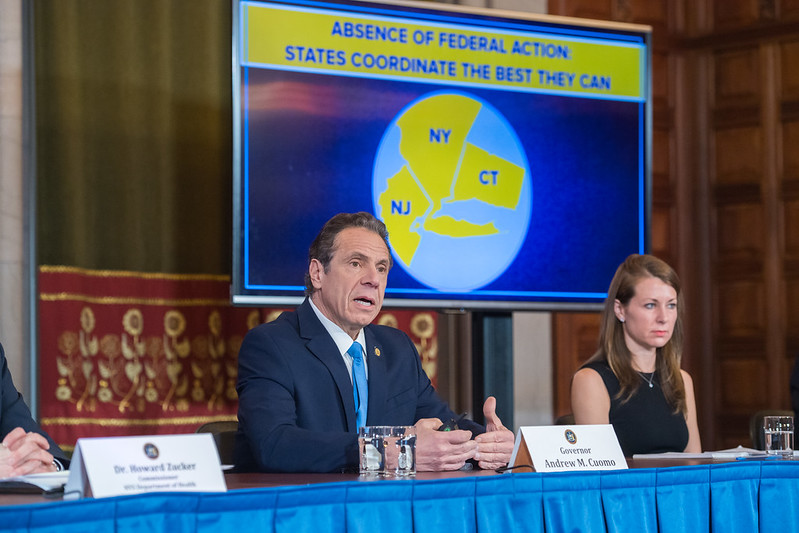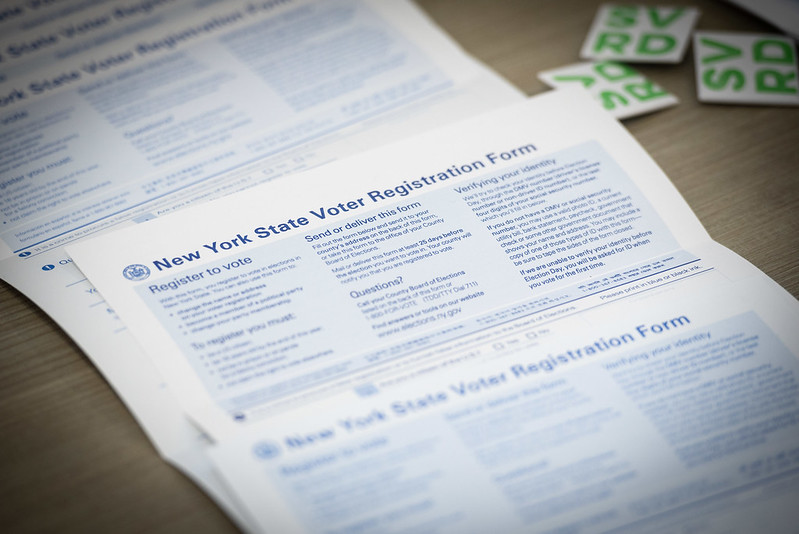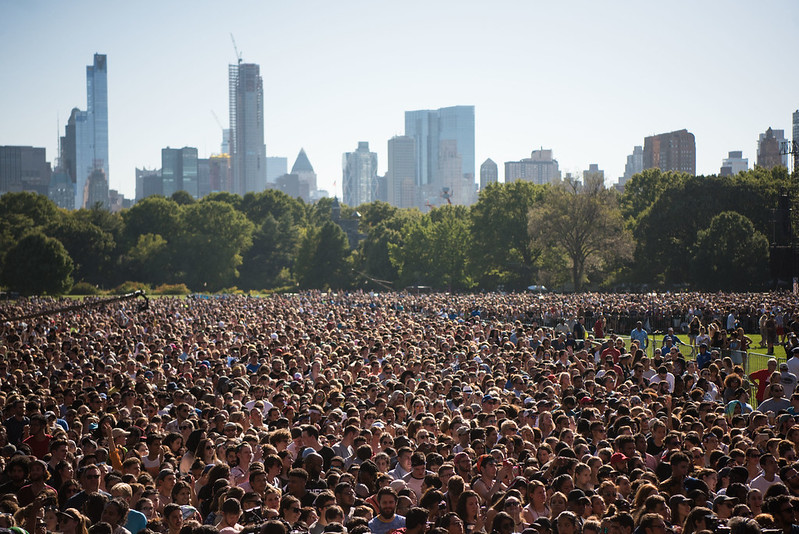Healing the New York Region with Coordinated Planning

An argument for a regional approach to recovery (photo: Darren McGee/Governor's Office)
Even for a metropolitan area that experienced the trauma of September 11, 2001 and the devastation of Superstorm Sandy, nothing could prepare residents of New York and their neighbors in New Jersey and Connecticut for the COVID-19 crisis. The death toll has already far surpassed that of the World Trade Center attack and will continue to climb. The economic damage is certain to exceed the job and income losses of those events and the 2008 financial crisis combined. The impacts on our collective psyche won’t be fully known until well after the pandemic has passed.
More than even in those earlier disasters, the response to this crisis requires a coordinated effort from the states and communities that are intricately tied together in family, social, and business networks that use the same roads, trains, stores, offices, schools, parks, and public spaces, drink the same water, and breathe the same air.
The decision by Governors Cuomo, Murphy, and Lamont, and their fellow governors in four other northeastern states, to form a Regional Coronavirus Reopening Council is an unprecedented collaboration that is crucial to reopening their interdependent economies. The council can have an even greater impact if it lays the foundation of a coordinated, long-term strategy to build a region that is healthier, fairer, and more resilient.
Planning for the recovery needs to start with the realization that the region is very sick and still in intensive care. Easing stay-at-home orders and other restrictions too soon will result in more deaths, a likely return to lockdowns and a longer recovery.
Returning to full physical and economic health will also require treating the underlying conditions that made us so susceptible to this disease.
The vastly disproportionate impact that this has had on black, Latino, and Native American populations, and the racial profiling the has been targeting the Asian community, is rooted in our history of racism and segregation. The sharp divides between the affluent, the middle-class, and low-wage workers without benefits or savings is a glaring outcome of decades of growing economic inequality. High levels of air pollution and other environmental hazards have always been a health risk, and appear to make us particularly susceptible to serious coronavirus effects. The fragility of vital systems like the transit network and unemployment insurance is the result of decades of underfunding and a failure to modernize. Slow adaptation to climate change will lead to even greater vulnerability and inequity. Even immediate measures to restart the economy need to address these fundamental flaws.
All of these conditions are national in scope and call for a concerted national response. But both the unique character of the region and the scale of the epidemic here require a vision and plan for the tri-state metropolitan area at least, if not the entire Northeast. The governors, through the regional council, can set a course that both speeds recovery and begins fixing structural problems.
A starting point for the long view can be Regional Plan Association’s 2017 Fourth Regional Plan, a once-in-a-generation vision for the tri-state metropolitan area. Many of its recommendations will need to be reassessed in a post-COVID-19 world, but the long-term challenges addressed in the plan are, if anything, now more important to overcome. The values of health, equity, prosperity, and sustainability that shaped the plan can guide the actions we take at each stage of recovery and renewal.
As we transition to recovery, the immediate focus on coordinating guidelines for reopening and physical distancing can shift to incorporating health goals and metrics in all regional and state agencies. New York State’s health-in-all-policies guidelines are a good place to start. These will be particularly important in reducing the vast disparities in health outcomes by race and income.
A united effort to secure the region’s fair share of federal transit assistance is the first order of business to keep the region’s circulatory system from spiraling into decline, but why stop there? With support from the governors, the region’s transportation agencies could join in creating a universal fare-payment mechanism and start to integrate rail services to allow more direct, one-seat rides to different parts of the region.
The council could spearhead an effort to give affordable, reliable Internet service to every household in the region, eliminating a leading source of both urban and rural inequality while reducing the region’s vulnerability in future disasters. This could set the stage for more difficult but essential conversations on how to expand affordable housing and reduce segregation throughout the metropolitan area.
An economic restart may be our best opportunity to rebuild in a way that supports a healthier environment and greater resilience to both future pandemics and climate change. Interstate cooperation to reopen the economy can be a foundation for large-scale climate initiatives, such as expanding regional greenhouse gas reduction programs, scaling up renewable energy, and capitalizing adaptation trust funds.
Recovering from the coronavirus pandemic will require a mobilization of the region’s talents, resources, and political will to a degree not seen since at least the deep fiscal crisis of the 1970s. We have a chance to not only recover much of what we lost, but to heal the wounds and divisions that new calamities would otherwise exploit.
***
Chris Jones is Senior Vice President and Chief Planner at Regional Plan Association. On Twitter @RegionalPlan.
***
Have an op-ed idea or submission for Gotham Gazette? Email This email address is being protected from spambots. You need JavaScript enabled to view it.
Protect Democracy with Vote-by-Mail and Online Registration

Next potential steps for voting in New York (photo: Michael Appleton/Mayor's Office)
The following is an excerpt from the 2019-20 NYC Votes Voter Analysis Report
Novel and frightening barriers to voting have the potential to upend the entire crucial 2020 election year in every state. The challenges of in-person voting during a pandemic are clear and significant. Elections traditionally provide a time for citizens to gather together in large numbers to engage in the practice of democracy. But restrictions on public gatherings recommended by public health authorities in response to the spread of COVID-19 cast regular poll site operations in a new light.
In jurisdictions around the country, many voters wait packed together in long lines to make their voices heard. Institutions that regularly serve as poll sites may be justifiably concerned about allowing potential carriers to pass through their doors—especially senior centers or schools. While early voting opportunities can provide space for voters to follow physical distancing guidelines, they offer no such protection to the dedicated poll workers who interact with each voter requesting a ballot.
In response, many election experts and advocates have advocated for prompt and widespread adoption of vote by mail.
Washington State, for instance, mails ballots to every registered voter 18 days before each election. Voters can mail their ballots back or return them to designated ballot drop boxes by the end of Election Day. Four other states—Colorado, Hawaii, Oregon, and Utah—conduct all-mail elections.
In New York State, mail-in or absentee voting is available only to voters who can attest to a specific reason they will be unable to appear at the polls, either for absence or illness. By executive order, Governor Cuomo expanded the meaning of “temporary illness” to cover those seeking to stem the spread of COVID-19, and mandated that every voter should receive an absentee ballot application in the mail. However, its effects are temporary. As issued, it applies only to elections through June 23. By whatever means are available, expanded access to vote by mail should be offered to New Yorkers on a permanent basis.
What we’ve learned in this moment is that universally-accessible vote by mail is not merely a turnout-boosting convenience. It can provide necessary resilience for our democratic system when the logistics of in-person balloting become impossible or impractical to maintain. It is one of a series of critical measures that should be available to administrators to ensure the continuity of our elections. New York should act promptly and decisively to implement it here.
The COVID-19 response effort is also shifting the way that organizers and campaigners approach the work of engaging voters. Traditional methods of registering voters will need to be rethought and campaign plans will need to be redesigned to adapt to the reality of an election year conducted during a pandemic. At minimum, a response that preserves New Yorkers’ access to elections through crises will require New York to finally end its reliance on a paper-based voter registration system that depends heavily on face-to-face interaction to bring new voters into the democratic process.
Times of crisis can force hard choices upon us; they demand we articulate our values and protect the things we value most. Elections are essential, particularly and especially in these difficult moments. In just the last twenty years, New Yorkers have come together to vote in the wake of a terrorist attack and in the aftermath of a destructive storm. Each instance demonstrates anew that our election laws and systems badly need flexibility to ensure elections can adapt effectively to public challenges like this one.
Democracy will persist — if we choose it.
***
Amy Loprest is the Executive Director of the NYC Campaign Finance Board, which runs the nonpartisan voter engagement initiative NYC Votes. Read the full 2019-20 NYC Votes Voter Analysis Report. On Twitter @NYCCFB & @NYCVotes.
***
Have an op-ed idea or submission for Gotham Gazette? Email This email address is being protected from spambots. You need JavaScript enabled to view it.
Aid to States is Important, But Next Federal Stimulus Must Truly Spark a People’s Recovery

The people must be prioritized, the authors write (photo: Michael Appleton/Mayor's Office)
New York remains the epicenter of the fight against the COVID-19 pandemic. And we remain short of resources to tamp down transmission of the virus and to provide the critical economic relief to working families and the most vulnerable New Yorkers.
Our representatives in Congress need to make sure we get those resources in the next stimulus bill. And starting this week, we’ve been gathering New Yorkers from all across the state to join in the fight for a People’s Recovery that will benefit all of us.
It’s not just “PPE” -- personal protective equipment -- but also workplace protections, cash assistance, healthcare, housing aid, and safe housing for those of us who are homeless or incarcerated that are now essential to caring for our people and preventing more community transmission of the virus.
This crisis has laid bare the devastating inequality in our state and the failures of austerity policies that have left most of our communities woefully unprepared, while the wealthy and well-connected escape to well-stocked hideaways, where many of them profiteer on the pandemic.
The devastation has been hardest on communities of color, consistent with the systemic inequities in our education, healthcare, and economic systems.
Frontline workers -- many of whom are immigrants and all of whom don’t have the privilege to stay at home -- are putting their lives on the line to save our lives, deliver essentials, and keep food on all of our tables. Meanwhile, immigrant, homeless, and incarcerated communities have been largely left out of pandemic policies and planning.
The first three federal stimulus packages along with the latest supplementary package failed to deliver relief to those who need it the most. And our new state budget failed to reverse a decade of austerity, instead choosing cuts to critical pandemic response services over asking the wealthiest New Yorkers to chip in more.
Yes, we do need more unrestricted federal resources for state and local governments. But we also need more for regular New Yorkers struggling with the twin healthcare and economic impacts of the pandemic.
Senate Minority Leader Chuck Schumer and our congressional delegation must do better for New York.
We cannot accept another corporate-first stimulus package. We need a People’s Recovery that will regenerate society and tackle institutional inequality head-on. The next stimulus must:
Repair dangerous gaps in worker protections and address dangerous exclusion of immigrant families.
Provide ongoing and universal income assistance paired with true financial relief.
Provide healthcare to all and protections to health care workers.
Fix gaping holes in corporate accountability and state governmental oversight.
Allocate the money needed to protect our democracy and elections.
Address the unfolding public health crises around incarceration and homelessness.
Starting this week, community, labor, faith, and Indivisible groups across New York will be holding online teach-ins on each of these key priorities to kickstart the advocacy. We expect our lawmakers to attend, to learn, and to take action that will save lives now and over the long run.
And we also expect our legislators to get back to work.
Workers across the country are adjusting to the requirements of social distancing. Why hasn’t Congress? It’s time to reconvene and implement the necessary procedures and technology solutions to ensure a fully functioning and transparent government.
The on-again-off-again backdoor negotiations are opaque and undemocratic. And the results show what’s wrong with doing it that way: outrageous corporate bailouts, insufficient oversight, and millions of New Yorkers left to fend for themselves.
The time for New York’s Congressional delegation to stand up and fight for our communities is now.
***
Ricky Silver is co-lead organizer with Empire State Indivisible. Michael Kink is the executive director of the Strong Economy For All Coalition. On Twitter @es_indivisible & @mkink.
***
Have an op-ed idea or submission for Gotham Gazette? Email This email address is being protected from spambots. You need JavaScript enabled to view it.




